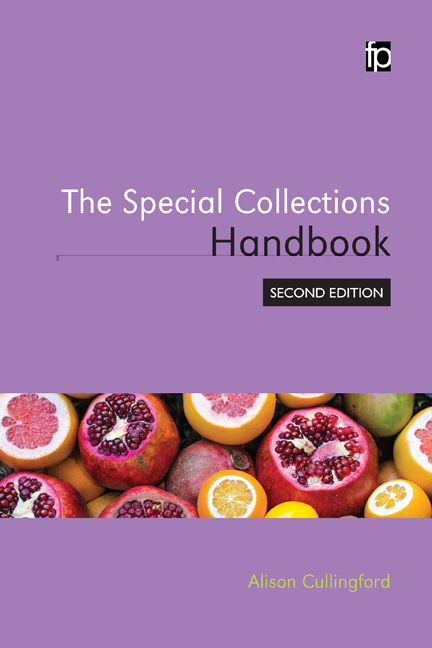Book contents
- Frontmatter
- Contents
- Preface and acknowledgements
- Introduction
- 1 The care of Special Collections
- 2 Emergency planning for Special Collections
- 3 Understanding objects in Special Collections
- 4 Acquiring and developing Special Collections
- 5 Cataloguing, description and metadata in Special Collections
- 6 Digitization and digital libraries in Special Collections
- 7 Legal and ethical issues in Special Collections
- 8 User services in Special Collections
- 9 Marketing and communications in Special Collections
- 10 Widening access to Special Collections
- 11 Organizational resources for Special Collections: space and people
- 12 Influencing and fund-raising for Special Collections
- Afterword: Special Collections futures
- Appendix A The Special Collections reference shelf
- Appendix B Skills for your Special Collections career
- Bibliography
- Index
4 - Acquiring and developing Special Collections
- Frontmatter
- Contents
- Preface and acknowledgements
- Introduction
- 1 The care of Special Collections
- 2 Emergency planning for Special Collections
- 3 Understanding objects in Special Collections
- 4 Acquiring and developing Special Collections
- 5 Cataloguing, description and metadata in Special Collections
- 6 Digitization and digital libraries in Special Collections
- 7 Legal and ethical issues in Special Collections
- 8 User services in Special Collections
- 9 Marketing and communications in Special Collections
- 10 Widening access to Special Collections
- 11 Organizational resources for Special Collections: space and people
- 12 Influencing and fund-raising for Special Collections
- Afterword: Special Collections futures
- Appendix A The Special Collections reference shelf
- Appendix B Skills for your Special Collections career
- Bibliography
- Index
Summary
Introduction
So how do libraries acquire their Special Collections? In this chapter, we consider:
Methods of acquisition: foundation collections, donation and deposit, purchase, internal transfer and proactive collecting.
How librarians can use these methods to ensure Special Collections are assets not problems.
Record-keeping issues in the acquisitions process.
Special Collections disposals.
Remote storage of Special Collections.
Bringing all these issues together in the Special Collections development policy.
Managing foundation collections
These are the libraries that were established by or grew with the organization that holds them. Originally gathered as working libraries, time has made them and their contents distinctive, and precious. Such collections are typically found in historic foundations such as cathedrals or ancient public libraries (for example, Chetham's Library and Innerpeffray, which you will visit elsewhere in this book).
Managing foundation collections is about ensuring that their historical importance to their organization is recognized. They should be high priority for conservation, salvage, cataloguing and digitization. Above all, they should not be dispersed. The sale or other breaking up of such collections is a great loss and strongly discouraged by professional bodies such as CILIP Rare Books and Special Collections Group (2015). We discuss disposals in more detail below.
If foundation collections have already been dispersed, projects to reunite them physically or intellectually can recreate what was lost. For example, the Sloane Printed Books Project created a database of the 40,000 books once owned by the scientist Sir Hans Sloane. Sloane bequeathed his books to the nation, creating one of the foundation collections of the British Museum Library, now the British Library (Walker, Macgregor and Hunter, 2012). Many of Sloane's books were dispersed in different British Library collections, or were sold in the British Museum's 18th- and 19th-century duplicate sales and are now held by other libraries, including the Wellcome Library.
Working with donors and depositors
Special Collections and their users everywhere owe a debt to the people who have donated or deposited collections to Special Collections services. Many great Special Collections libraries bear the names of such donors: the Huntington Library, the John Rylands Library, the Lilly Library, the Brotherton ….
- Type
- Chapter
- Information
- The Special Collections Handbook , pp. 67 - 90Publisher: FacetPrint publication year: 2016



